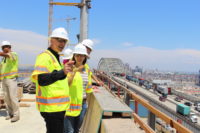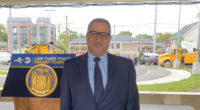Houssam “Sam” Sleiman serves as executive vice president for national transportation at Suffolk. He is responsible for leading the company’s operations in the transportation sector and driving business development for aviation, port and railway projects nationally. Suffolk brought Sleiman on late last year after he spent nearly 30 years leading capital programs and environmental affairs at the Massachusetts Port Authority. Sleiman was named one of Engineering News- Record’s Top 25 Newsmakers of 2009 for pioneering the use of warm-mix asphalt on a U.S. runway.
This interview was edited and condensed.
What prompted you to join Suffolk?
I’d spent 27 years with Massport. Due to the pandemic, we had to cancel a lot of projects. When John [Fish, chairman and CEO] approached me about creating a national transportation group for Suffolk, I thought it was time.
Suffolk did renovations to Terminal B and is now working on the international terminal extension, building a connection between Terminals C and B and the CONRAC. Knowing Suffolk and their culture, it was an easy decision to go with them.
What is the culture like? What is your main role?
One of the things construction companies have done well is trying to build innovatively. Suffolk is leading that innovation. It’s really using data and new software to make things more efficient. My role is all about trying to elevate the service Suffolk provides to this industry to the next level. I understand aviation operations, logistics, the business.
Are you optimistic about the future of aviation projects? How do we plan for the short and long-term, post-pandemic?
Aviation got hit really hard by COVID. I’ve been in the business through several challenges—9/11, 2008. This one is definitely the most impactful. There were fewer passengers to pay PFCs [Passenger Facility Charges], or landing fees, concessions, parking—all the revenues we rely on to do bonds and do work are not there. Airport projects that are ongoing are those that already sold bonds based on PFCs. Short term, the industry struggling to make ends meet. But we know it’s the most resilient industry. It will come back with a vengeance. We will start to see that after the vaccine. By end of the year, we may be back at 60% [of airports’ annual passenger traffic].
Here’s the challenge: Before COVID, airports were growing at a higher pace than anticipated. 2040 numbers were already being reached. We were behind the 8-ball in planning facility improvements because passenger growth was so high. Now, it’s the opposite situation but knowing they’ll come back.
We should be implementing projects now for two reasons: First, so that we’re not behind the 8-ball in two to three years. And right now, we can do them more efficiently; we can do bigger phases now.
People want to fly. There’s a pent-up anxiety. Domestic travel is going to be recovering faster than international.
How will airport terminal designs change?
Viruses are not one and done. We have to build facilities in ways that are flexible and anticipate future challenges to the industry. A lot of technology got advanced in response—especially touchless technology. Facial recognition, checking in on the phone. Security checkpoints, boarding areas, gathering areas, all need to be rethought.
The other thing is about the materials airports use. Carpets in holdrooms cost less than terrazzo. But furniture with fabric can’t be cleaned as well versus leather or vinyl.
Is Suffolk expanding its transportation practice?
Yes. Aviation, maritime and rail. We are in all three sectors.
We have 10 offices, including three in California, four in Florida, and New York, Dallas and Boston. We’re starting to diversify into transportation; for example, we are working on a Miami cruise terminal.






